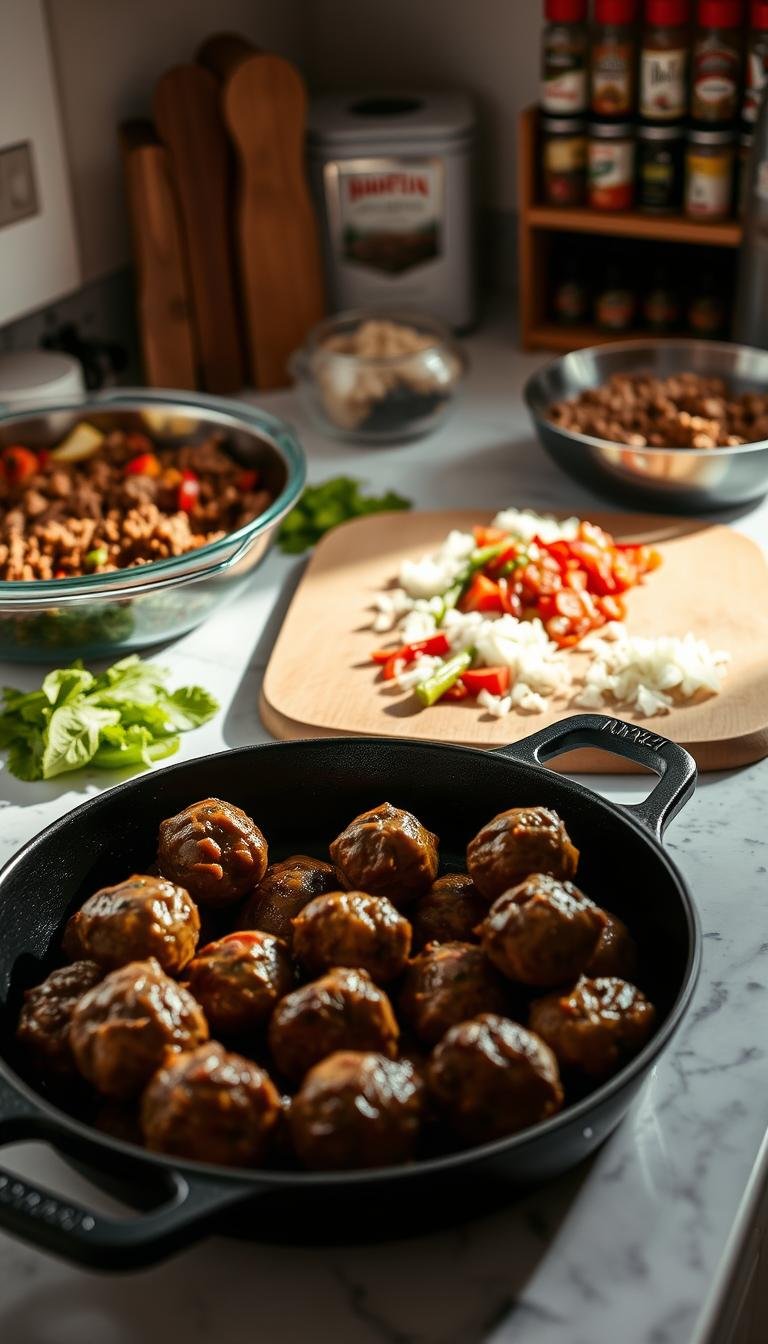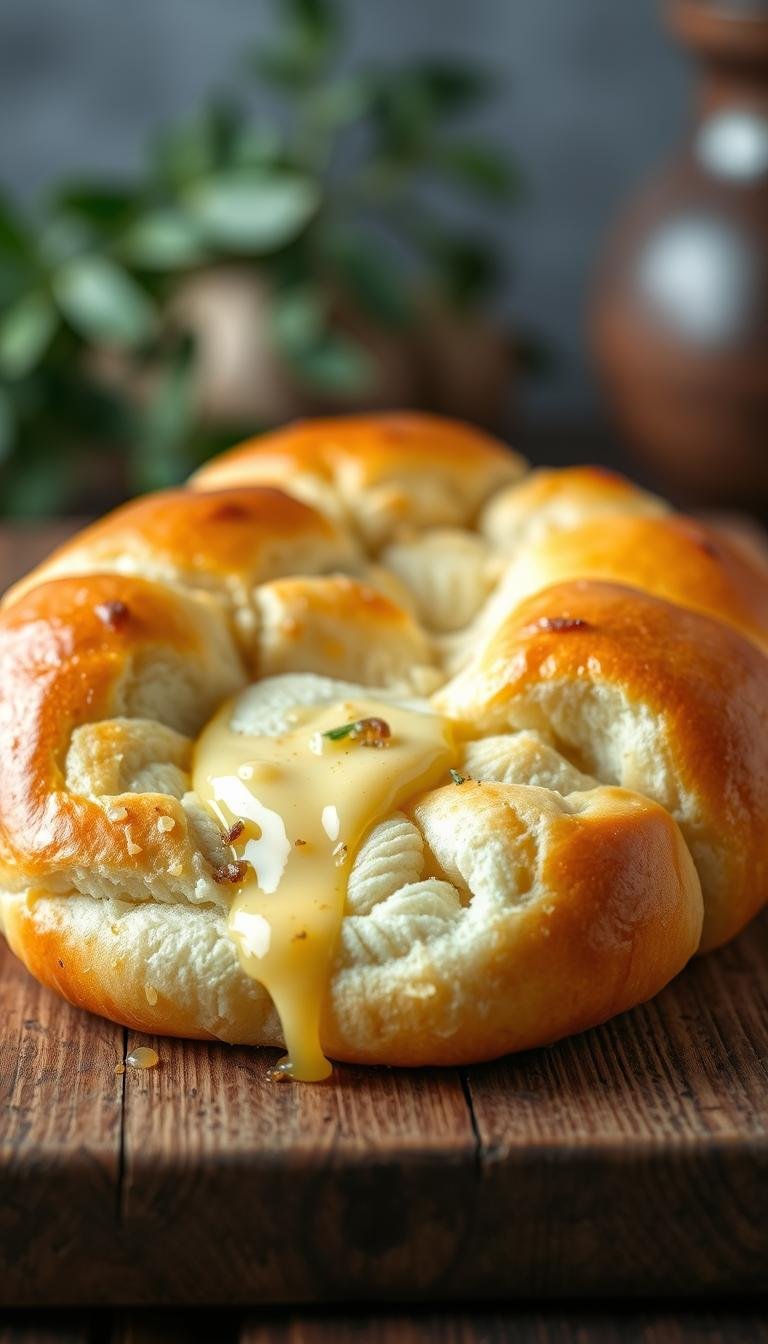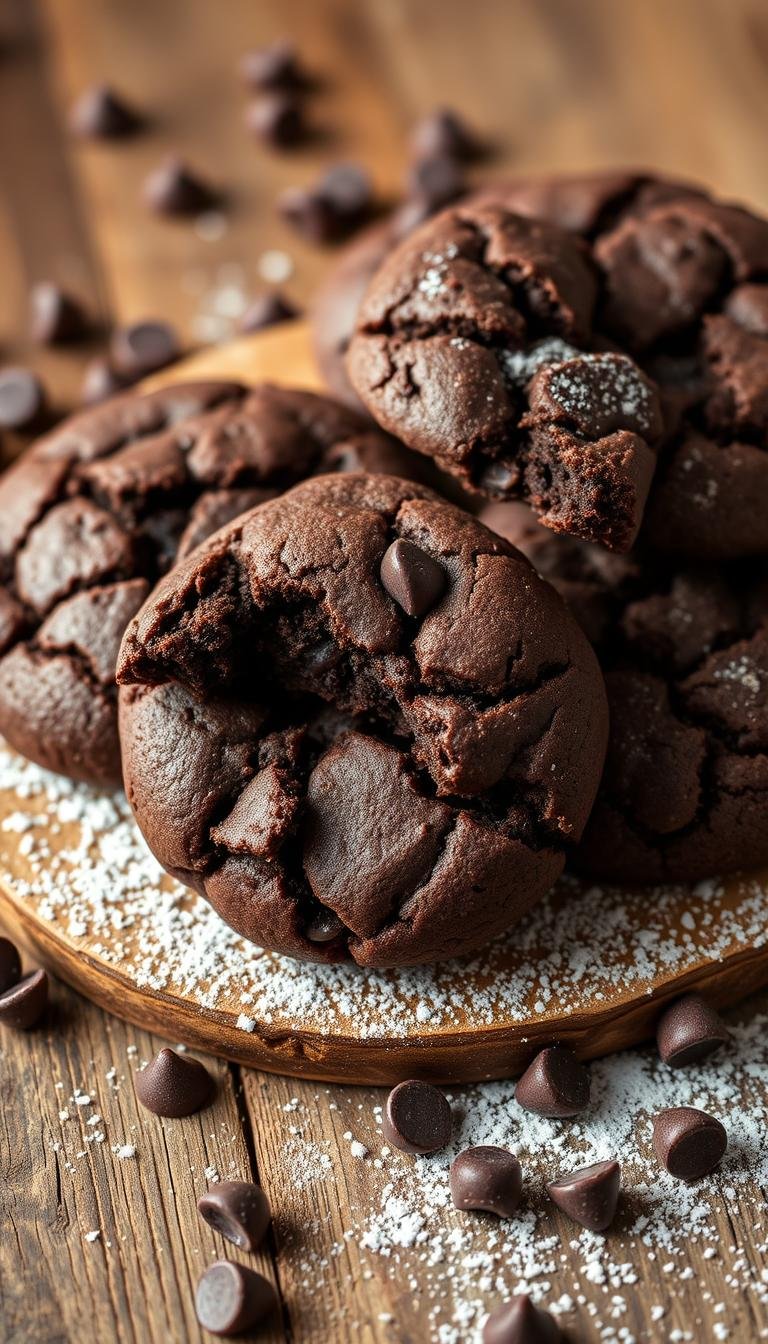Delicious Easy Dinner Recipes with Ground Beef
Nearly 60% of home cooks say they turn to quick skillet meals on weeknights — and for good reason.
This post shows how a pound or two of ground beef can become a warm, satisfying meal fast. You’ll find three clear options that use pantry staples and smart techniques.
Expect bold flavor and familiar comforts like gravy, potatoes, rice, and a Korean-style sweet-savory bowl. Each dish focuses on speed, reliable protein, and straightforward steps so results stay consistent.
Instructions cover ingredients, cooking flow, heat control, and fat management. Storage tips make leftovers work for another night without extra fuss.
Key Takeaways
- One-pound packs turn into fast, scaled meals for individuals or families.
- Pantry staples and clear techniques cut prep and cook time.
- Three crowd-pleasing dishes offer variety while keeping cleanup low.
- Tips on heat, fat, and pan choice ensure consistent results.
- Smart storage ideas help leftovers become a ready second meal.
Why these quick skillet dinners work on busy weeknights
A single skillet can turn pantry staples into a flavorful weeknight meal in under 30 minutes.
Efficient heat transfer in a hot pan creates fast browning. That Maillard crust builds deep flavor without long oven time. A small amount of oil helps jump-start searing and softens aromatics while residual heat finishes sauces and glazes.
Ground beef cooks and breaks up quickly, takes on seasonings fast, and needs only a short simmer to develop rich taste. This method keeps everything in one pan, so cleanup and dish count stay low.
“Sear to gain color, then lower the flame to finish—this simple control prevents overcooking and burned sauces.”
- Pantry staples like Worcestershire, soy, or Dijon boost depth without extra time.
- Swap vegetables freely; the approach scales for two to six servings.
| Benefit | Why it works | How to apply |
|---|---|---|
| Speed | High heat and direct contact cut cook time | Preheat pan, sear, then lower heat to finish |
| Flavor | Browning concentrates savory notes | Use a little oil and an initial high sear |
| Flexibility | Ground meat and staples adapt to swaps | Stir in veggies late to keep cook times steady |
easy dinner recipes with ground beef: what to expect and how to use this recipe post
Think of this post as a toolkit: three skillet-forward builds, simple ingredients, and clear timing cues to help you cook faster and waste less.
Fast, flavorful, budget-friendly meals in minutes
Expect three core builds: a 20-minute gravy classic, a one-pan beef-and-potatoes skillet, and a sweet-savory Korean-style bowl. Each recipe shows the key ingredients, pacing for minutes at the stove, and where to hold or add seasoning to suit your household.
Pantry staples and a large skillet do the heavy lifting
Stock items like broth, soy, Dijon, smoked paprika, and dried onion elevate simple protein. A roomy skillet prevents crowding so ground and veggies brown, not steam, which boosts flavor fast.
Make-ahead, leftovers, and next-day lunches
Portion cooked protein into airtight containers, then refrigerate for 3–4 days or freeze up to 3 months. Reheat gently and add a splash of broth to restore moisture.
- Prep sauces ahead to cut time midweek.
- Double batches and repurpose leftovers into hashes, wraps, or bowls.
- Swap veggies or starches without changing the basic method.
| Build | Time | Storage |
|---|---|---|
| Gravy classic | 20 minutes | Fridge 3 days / Freeze 3 months |
| Beef & potatoes skillet | 25 minutes | Reheat as hash or wrap |
| Korean-style bowl | 15 minutes | Fridge 4–5 days / Freeze 3 months |
Use this post as a template: once you learn the flow, you can make recipe swaps confidently based on what’s in your fridge and still get reliable results.
Comfort classic: Ground Beef and Gravy in 20 minutes
A short, focused stove-top routine yields a rich gravy and tender browned meat in under twenty minutes.
Simple ingredients: 1 pound 80/20 ground beef, 2 tablespoons butter, 2 cloves garlic (minced), 1 tablespoon dried minced onion, 1/2 teaspoon black pepper, 2 tablespoons flour, 2 cups beef broth (low/ no sodium optional), and 1 tablespoon Worcestershire.
Step-by-step
- Start in a large skillet over medium-high heat. Brown the ground for 8–10 minutes, then drain excess fat.
- Lower to medium and add butter. Sauté garlic, onion, and pepper for 30 seconds.
- Stir in flour and cook 1 minute to form a light roux.
- Slowly whisk in 2 cups broth, then add Worcestershire. Simmer about 5 minutes until the sauce coats a spoon.
Serve and store
Spoon over mashed potatoes, egg noodles, or steamed rice.
| Step | Time | Key measure |
|---|---|---|
| Brown meat | 8–10 minutes | 1 pound |
| Build roux & sauce | 6 minutes | 2 tablespoons flour |
| Simmer | 5 minutes | 2 cups broth |
Storage: Refrigerate up to 3 days or freeze 3 months. Reheat gently in a pan with a splash of broth to loosen the sauce.
One-pan Ground Beef and Potatoes Skillet with bell pepper
Golden potatoes, seared meat, and bright peppers come together fast in a single skillet for a hearty plate. This build uses simple spices to pull savory and smoky notes through every bite.
Flavor makers
Use smoked paprika, Dijon mustard, Worcestershire, garlic powder, dried oregano, and a splash of hot sauce. These pantry staples add depth without fuss.
Cook flow
Heat 2 tablespoons canola oil in a large skillet, then reduce to medium. Add 1 pound diced potatoes; cook about 6 minutes until golden but still firm.
Stir in 1 pound 93% lean ground beef, 1 diced small yellow onion, and 1 diced red bell pepper. Break the meat apart as it cooks.
Season with 1 tablespoon Worcestershire, 1 teaspoon Dijon, 2 teaspoons smoked paprika, 1 teaspoon garlic powder, 1 teaspoon dried oregano, 1 teaspoon kosher salt, 1/4 teaspoon black pepper, and 1–2 teaspoons hot sauce. Cook 6–8 minutes more until potatoes and onion are tender. Stir in sliced green onions to finish.
Leftovers you’ll love
Store in the fridge up to 3 days. Reheat gently or re-crisp in a pan for a quick hash. Wrap warmed filling in a tortilla for a handheld meal. Freezing is not recommended because potatoes lose texture.
| Step | Time | Servings | Notes |
|---|---|---|---|
| Potatoes sauté | 6 minutes | 4 | Use diced Yukon or russet |
| Cook meat & veggies | 6–8 minutes | 4 | Stir to brown evenly |
| Finish & serve | 2 minutes | 4 | Top with green onions |
| Approx. calories | — | Per serving | 387 kcal |
Sweet-savory Korean Ground Beef over rice
A fast skillet method combines bold sauce flavors and tender browned meat for a weeknight crowd-pleaser.
Bold sauce: whisk 1/2 cup soy sauce (low-sodium ok), 1/2 cup orange juice, 1/2 cup brown sugar, 1/4 cup sweet chili sauce, 2 teaspoons toasted sesame oil, and 1 tablespoon cornstarch until smooth.
Quick technique
Heat 1 tablespoon oil in a skillet over medium-high. Add 2 pounds ground and 4 cloves minced garlic; brown 3–5 minutes, then drain fat.
Pour the sauce over meat and reduce to medium. Simmer until slightly thickened so the sauce clings to the meat. Garnish with sliced green onions.
Serving ideas & storage
Serve over hot rice and add steamed broccoli, snap peas, or use lettuce wraps, ramen, or udon for variety.
- Refrigerate 4–5 days or freeze up to 3 months.
- Reheat gently with a splash of broth to loosen sauce.
- Use low-sodium soy to cut overall sodium, and adjust sugar or chili to taste.
The one-pan game plan: from skillet to table with minimal cleanup
A smart sequence turns one pan into a finished plate in minutes and keeps cleanup light. Start hot to build color, then slow the flame to finish sauces and soften aromatics.
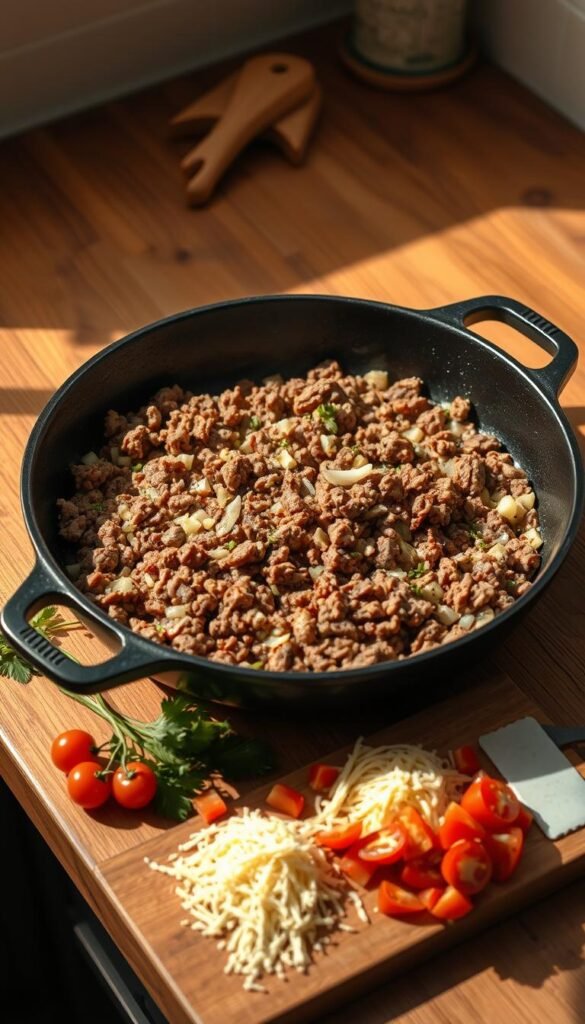
Heat management
Use medium-high heat at first to sear meat and lock in flavor. Let the surface brown before you stir; that fond is the base for a rich sauce.
After browning, lower to medium to finish cooking and to keep the sauce silky. Watch moisture and add a splash of broth if the pan looks dry.
Grease and fat
Drain excess fat so sauces do not split or taste heavy. If you choose very lean ground beef, add a small amount of oil to prevent sticking and to carry spices.
“Deglaze the pan to capture browned bits — it adds depth without extra time.”
- Use a roomy large skillet so meat spreads out and browns instead of steaming.
- Stir enough to avoid burning but give the meat time to color for best texture.
- Season in layers: salt while browning, then taste after the sauce reduces.
| Focus | Action | Why it matters |
|---|---|---|
| Initial sear | Medium-high heat, 3–5 minutes | Builds color and savory base for sauce |
| Finish | Lower to medium, simmer few minutes | Keeps sauce smooth and meat tender |
| Fat control | Drain or add a little oil | Prevents greasy results and sticking |
Nutritional snapshot: protein, calories, sodium, and fiber considerations
A fast glance at protein, calories, and sodium can guide portion size and side choices.
Protein stays front and center: most servings deliver about 20–26 grams. The gravy portion is ~26 g protein and ~238 calories per serving, while the potato skillet is ~387 calories and the Korean-style bowl hits ~404 calories per cup.
Choosing lean blends and balancing fat and flavor
Pick lean or a lean ground blend when you want less fat. Drain excess grease after browning and finish with bright acids like a splash of orange juice or a teaspoon of Dijon to lift richness.
Small swaps—Greek yogurt instead of cream—cut calories and keep texture. Watch sodium: use low-sodium broth or soy and add final salt sparingly after tasting.
Veggie add-ins for vitamins and fiber without extra minutes
Stir in diced onion, bell pepper, peas, or broccoli near the end to boost fiber and vitamin C and A. These add-ins cook quickly and make plates more filling.
| Build | Calories (approx) | Protein (g) | Sodium tip |
|---|---|---|---|
| Gravy classic | 238 | 26 | Use low-sodium broth |
| Beef & potatoes | 387 | 20–25 | Limit added salt; taste at the end |
| Korean-style bowl | 404 | 22–28 | Swap low-sodium soy to cut sodium |
“Small shifts in ingredients change macros more than technique does.”
Ingredient swaps and pantry pivots that still deliver flavor
Small ingredient changes can transform a familiar skillet into a lighter, pantry-friendly meal. This helps when you need to swap proteins, cut sodium, or swap thickeners without losing the dish’s heart.
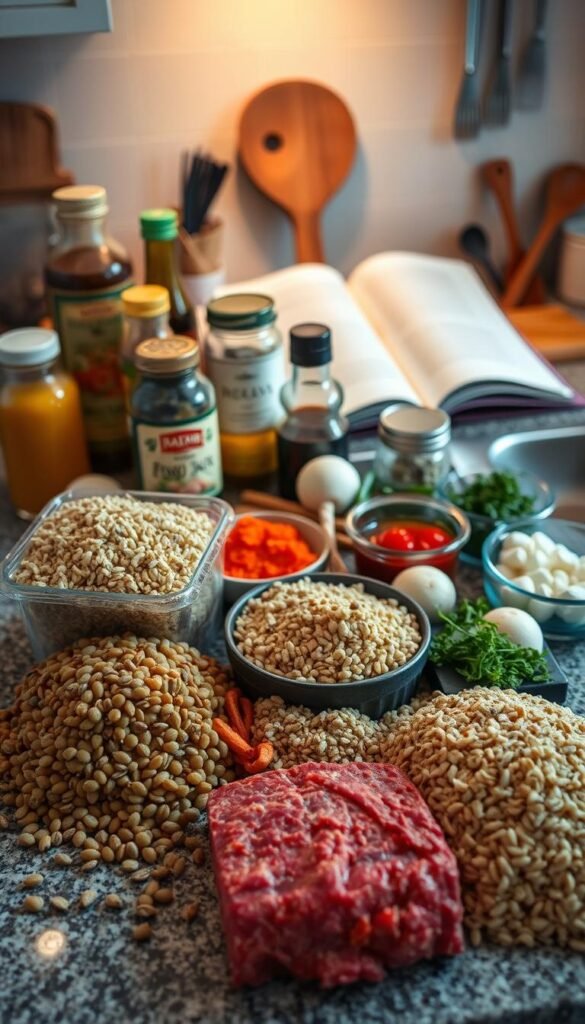
Protein swaps: Use ground turkey or chicken for a lighter profile. Match the broth—use chicken or vegetable stock—to keep flavors cohesive. When you make ground beef swaps, watch doneness so poultry reaches a safe internal temp without drying out.
Quick pantry pivots
- Low-sodium broth or soy cuts sodium while keeping depth; add final salt to taste.
- Cornstarch works faster than flour and gives a glossy sauce; it’s gluten-free and easy to mix.
- Fresh onion adds sweetness and texture; dried minced onion saves time and concentrates aroma.
- For more veggies, toss in bell pepper, peas, mushrooms, or broccoli—these absorb sauce and cook quickly.
Use Worcestershire, Dijon, or sweet chili to tilt flavors toward smoky, tangy, or sweet-spicy. Opt for lean ground blends and drain excess fat so sauces do not split. If you choose ultra-lean, a teaspoon of oil prevents sticking and helps bloom spices.
“Bloom spices briefly in hot fat to release aromas before adding liquids.”
| Swap | Why | Tip |
|---|---|---|
| Turkey or chicken | Lighter fat profile | Match stock; monitor doneness |
| Cornstarch for flour | Faster, glossy sauce | Mix with cold water, then stir in |
| Fresh vs. dried onion | Texture vs. convenience | Use dried for speed; fresh for bite |
Serving suggestions: rice, noodles, mashed potatoes, and beyond
Pick a hearty starch or a light grain to carry the savory sauces in these builds. A thoughtful base makes plating faster and boosts texture without extra work.
Classic sides
Mashed potatoes pair beautifully with the gravy—creamy texture balances rich beef and sauce. Egg noodles are a quick route to comfort. Use brown rice or cauliflower rice to cut carbs and add fiber.
Toppings and finishes
Simple touches elevate every bowl. Spoon yogurt or sour cream on the potato skillet, or add shredded cheddar for richness. Crown Korean-style beef with green onions or a fried egg to make the meal feel diner-style.
- Pair the gravy over mashed potatoes, egg noodles, or hot rice for classic appeal.
- Spoon the potato skillet into bowls with Greek yogurt or cheddar; also try it over brown rice or cauliflower rice.
- Serve the Korean-style beef over rice, ramen, or udon, or tuck into lettuce wraps with steamed broccoli or snap peas.
- Add steamed veggies to boost color, texture, and fiber.
- Finish with a pinch of salt, a crack of pepper, a drizzle of hot sauce, or a teaspoon of sesame seeds for polish.
| Base | Best match | Why it works |
|---|---|---|
| Mashed potatoes | Gravy classic | Creamy texture collects sauce and adds comfort |
| Rice (white or brown) | Korean-style or gravy | Neutral grain that soaks up sauce and balances sugar and soy flavors |
| Egg noodles / ramen / udon | All builds (especially Korean) | Slippery texture pairs with bold sauces and garlic notes |
| Cauliflower rice | Lighter plates | Low-carb option that lets veggies and beef stand out |
“Use a warm cup of broth to loosen refrigerated portions when reheating so the sauce returns to a silky consistency.”
Conclusion
Finish strong: three skillet-based plates that balance quick technique and pantry-friendly flavor. Each build gets you a solid meal in minutes while keeping cleanup low.
Brown meat first, manage heat, and drain excess grease. Layer the sauce, taste, and finish with a measured teaspoon or cup to keep results consistent.
These recipes let you stretch protein, control calories, and add vitamin-rich veggies for balance. Swap in chicken or turkey, use cornstarch instead of flour, and store portions for 3–4 days so leftovers shine as next-day meals.
Save or print favorites and note small tweaks—those adjustments lock in a family-approved plate you can make again and again.
